![]()
Those who master large-scale software delivery will define the economic landscape of the 21st century.
—Mik Kersten, Project to Product [1]
Business Agility
Business Agility is the ability to compete and thrive in the digital age by quickly responding to market changes and emerging opportunities with innovative, digitally-enabled business solutions.Everything moves fast in the digital age. Customer desires, competitive threats, technology choices, business expectations, revenue opportunities, and workforce demands now happen at blistering speeds.
Today, achieving customer delight at the speed of market changes requires validating innovations with customers and then ‘pivoting without mercy or guilt’ when the hypothesis needs to change. Moreover, significant technological advances are unlocking new ways to create this value. For example, AI, Big Data, Cloud, and DevOps enable enterprises to expand their product lines, modernize their existing offerings, scale to mass markets, make fact-based decisions, and streamline solution development.
Competing in the Age of Software
In her book, Technological Revolutions and Financial Capital [2], Carlota Perez explains the evolution of business, society, and financial cycles based on her analysis of five significant technological revolutions over the past three centuries. Her research begins with the Industrial Revolution, leading to the ‘Age of Steam and Railways,’ ‘Age of Steel and Heavy Engineering,’ and more to the present “Age of Software and Digital,’ as illustrated in Figure 1.
Perez concludes that these revolutions lead to massive social change, market disruption, and a new economic order. Indeed, these are world-shaking disruptions that typically occur perhaps once in a generation.
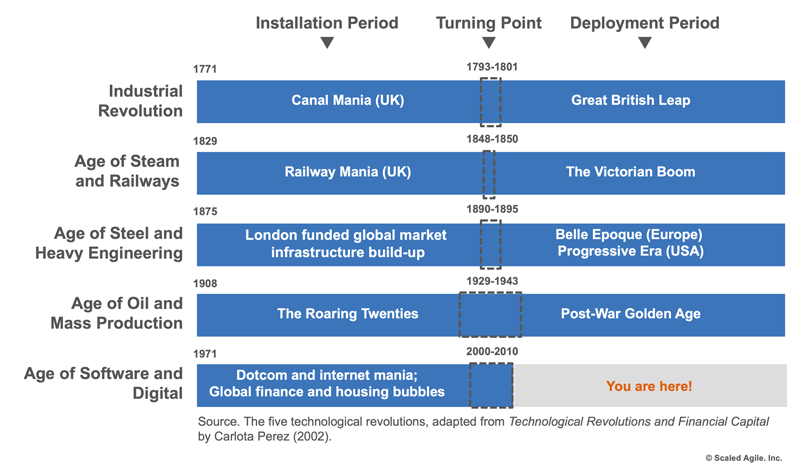
Clearly, we are in the midst of one of those ages now, the deployment period of the age of software and digital. This is a time when every business is a software business. Put simply, competing in the deployment period requires large-scale software and system development capability that enables true business agility.
Why Organizations Struggle to Achieve Business Agility
“The organizations we created in the 20th century were designed much more for reliability and efficiency than for agility and speed.” — John P. Kotter
Most leaders are aware of the digital disruption threat, and yet many fail to make the transition to take their place in the next economy. The question is, why? In part, it is because the traditional hierarchy — which served us so well to this point— is not built for a world where fast change is the norm.
Organizations Start as a Fast Adaptive Network
As an organizational researcher and author, John Kotter illustrates in his book, Accelerate: Building Strategic Agility for a Faster-Moving World [3], successful enterprises don’t start out large and cumbersome. Instead, they typically began as a fast-moving, adaptive network of motivated individuals focused on responding to the customer and the new business opportunity. Roles and reporting relationships are fluid, and people collaborate organically to identify customer needs, explore potential solutions, and deliver value in any way they can. In other words, it’s an adaptive ‘entrepreneurial network’ of people working to leverage an opportunity (Figure 2).
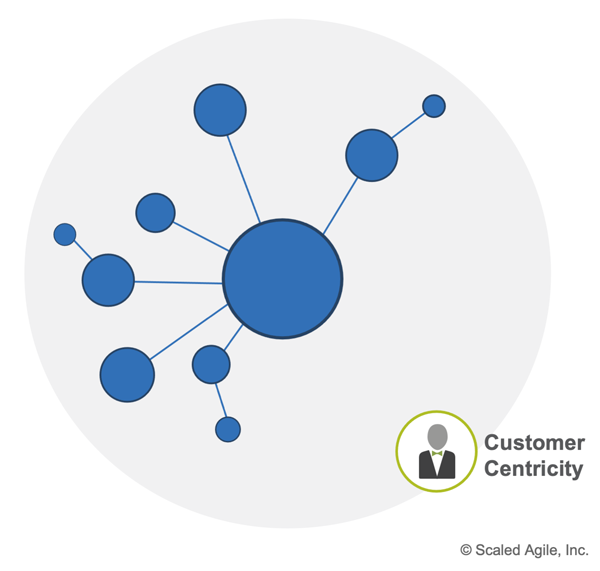
Hierarchy Grows and Grows to Scale
As the enterprise succeeds, it naturally wants to expand on its success and grow. This growth means that individual responsibilities must become clearer to ensure critical details are carried out. As a result, specialists are hired to add expertise, and new functional areas are created. Policies and procedures are established to ensure legal adherence and compliance, driving repeatable, cost-efficient operations. The business starts to organize functionally to scale, causing silos to form. Meanwhile, operating in parallel, the network continues to seek new opportunities to deliver value (Figure 3).
Achieving larger economies of scale requires the hierarchy to grow. And grow until it conflicts with the entrepreneurial network.
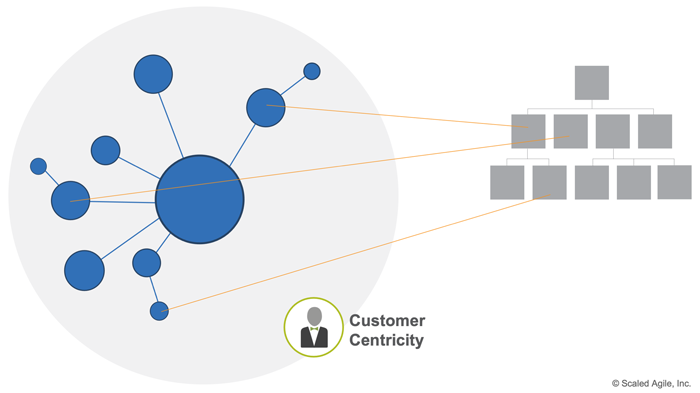
The Hierarchy and Adaptive Network Collide
Eventually, with the authority of current revenue and profitability behind it, the hierarchy collides with the faster-moving, more adaptive network. The result? The network gets crushed in the process. The focus on the customer is often one of the casualties (Figure 4.)
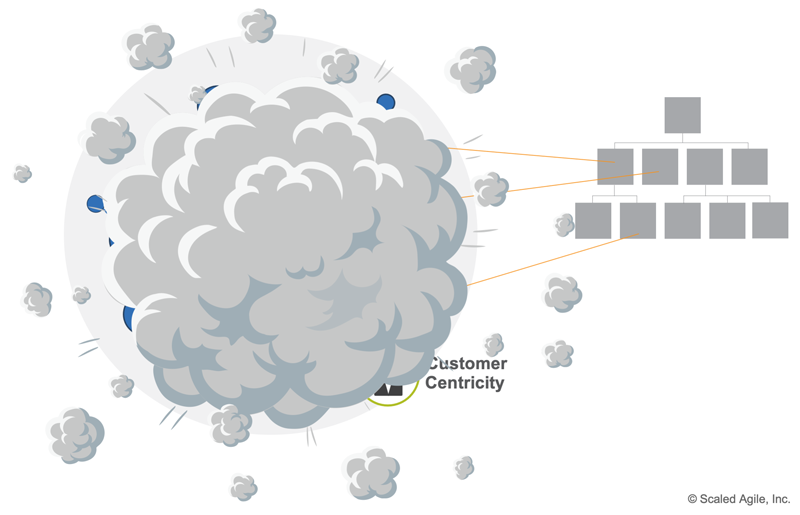
But without the entrepreneurial network, the organization lacks the agility to respond when the customer needs shift dramatically or when a disruptive technology or competitor emerges. An urgent crisis erupts, and the company’s survival is now at stake.
However, the organizational hierarchies built over the last fifty years have provided time-tested structures, practices, and policies. They support the recruiting, retention, and growth of thousands of employees across the globe. Simply put, they are still needed.
In addressing this dilemma, Kotter points out, “The solution is not to trash what we know and start over but instead to reintroduce a more agile, network-like structure that operates in concert with the hierarchy to create what he calls a “dual operating system.” This system, illustrated in Figure 5 and described in the following section, allows companies to capitalize on rapid-fire strategic challenges and retain their stability [1].”
The Solution: SAFe Offers a Dual Operating System
In this dual operating system, the existing hierarchy, people, and management largely remain. However, a second virtual operating system is organized around Development Value Streams to realize the entrepreneurial network.
Within each Development Value Stream, one or more Agile Release Trains (ARTs) have a shared business and technology mission. Each ART plans, commits, develops, and deploys together.
While the management reporting structure may remain the same, the teams in an ART are self-organizing and self-managing and no longer need daily task direction. This new virtual organization breaks down the traditional functional silos that inhibit flow and innovation.
By organizing the second operating system around value streams instead of functions, SAFe offers a way for organizations to focus on customers, products, innovation, and growth in harmony with their existing hierarchical structure.
Moreover, this dual operating system is flexible. It is built on time-tested Lean-Agile SAFe practices. It can organize and quickly reorganize without completely disrupting the existing hierarchy, as illustrated in Figure 5. That’s what business agility demands.
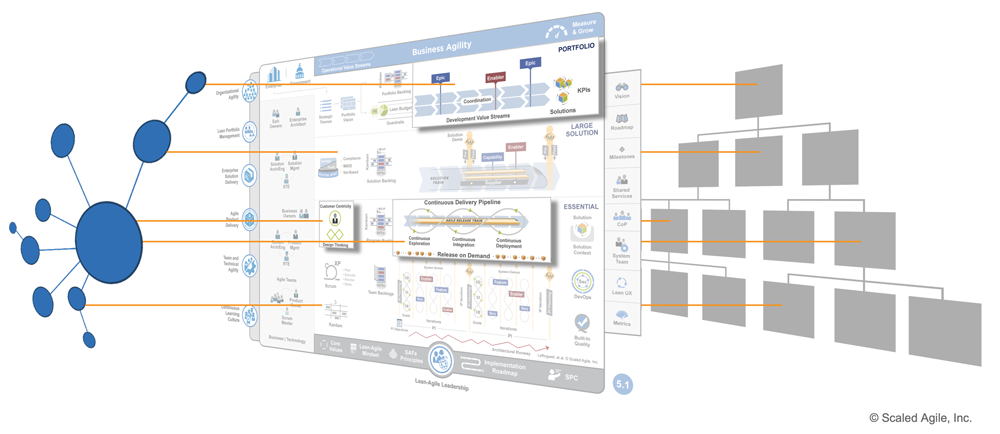
Business Agility Value Stream
SAFe defines Business Agility as the ability to compete and thrive in the digital age by quickly responding to market changes and emerging opportunities with innovative, digitally-enabled business solutions. By implementing SAFe, enterprises inherently develop the Lean, Agile, and DevOps capabilities that enable incremental delivery at scale through the entire ‘Business Agile Value Stream’ (BAVS), from sensing an emerging opportunity to delivering the right solution (Figure 6). Traditional approaches using phase-gate and waterfall delivery are simply too slow to the challenge.

This requires all functions, processes, activities, teams, and events from end to end to be aligned and optimized for maximum speed and quality:
- Sense opportunity – Sensing an opportunity involves market research, customer feedback, and direct observation of customers in the marketplace. More importantly, it demands that senior executives thoroughly understand the customer and the market. A “go see” (Gemba) mentality provides a rich source of ideas and possibilities.
- Fund MVP – Quickly leveraging an identified opportunity requires a flexible, lean approach to funding the people and resources needed to produce the Minimum Viable Product (MVP) – an initial solution sufficient to test the business hypothesis and deliver the first increment of value.
- Organize around value – The rapid development of the MVP hinges on cross-functional Agile Teams and Agile Release Trains that organize and reorganized around customer value.
- Connect to the customer – ARTs apply Customer Centricity and Design Thinking to understand the customer’s problem and define new solutions that help customers achieve their objectives.
- Deliver MVP – ARTs quickly deliver an MVP through rapid, synchronized iteration and PI cycles. This provides an empirical foundation for further product management, development, and funding decisions.
- Pivot or persevere – Depending on the learnings from the MVP, the organization will either abandon the initiative, pivot to a new opportunity, or continue to invest in the solution as the facts and economics dictate. When persevering, the Continuous Delivery Pipeline minimizes the cost of delay and provides the ability to deliver value continuously.
- Learn and adapt –The ability to measure, learn, and adapt is integral to the process and offers routine opportunities to adjust direction.
The goal is to establish a fast flow of value through a series of steps—the entire business agility value stream—and ensure the delivery of solutions that enables the business opportunity.
Core Competencies of Business Agility
Achieving business agility a degree of expertise across SAFe’s seven core competencies, as illustrated in Figure 7.

While each competency can deliver value by itself, they are mutually dependent. True business agility can be present only when the enterprise achieves reasonable mastery of all. It’s a tall order, but the path is clear.
Each core competency is described briefly below and is linked to a SAFe article that offers more guidance:
| Lean-Agile Leadership – How Lean-Agile Leaders drive and sustain organizational change and operational excellence by empowering individuals and teams to reach their highest potential. | |
| Team and Technical Agility – The critical skills and Lean-Agile principles and practices that high-performing Agile teams and Teams of Agile teams use to create high-quality solutions. | |
| Agile Product Delivery – A customer-centric approach to defining, building, and releasing a continuous flow of valuable products and services to customers and users. | |
| Enterprise Solution Delivery – How to apply Lean-Agile principles and practices to the specification, development, deployment, operation, and evolution of the world’s largest and most sophisticated software applications, networks, and cyber-physical systems. | |
| Lean Portfolio Management – Aligning strategy and execution by applying Lean and systems thinking approaches to strategy and investment funding, Agile portfolio operations, and governance. | |
| Organizational Agility – How Lean-thinking people and Agile teams optimize their business processes, evolve strategy with clear and decisive new commitments, and quickly adapt the organization to capitalize on new opportunities. | |
| Continuous Learning Culture – A set of values and practices that encourage individuals—and the enterprise as a whole—to continually increase knowledge, competence, performance, and innovation. |
Mastery of these seven core competencies enables organizations to achieve the agility needed to respond to volatile market conditions, changing customer needs, and emerging technologies.
Measuring the Business Agility Value Stream
It is difficult to improve what isn’t measured. SAFe provides three measurement domains, outcomes, flow, and competency, (Figure 8) to measure business improvement.
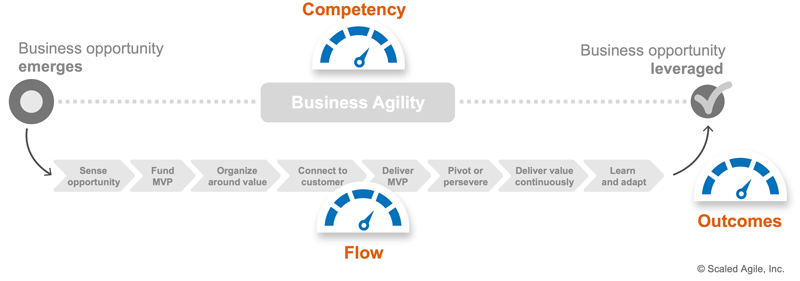
- Outcomes help ensure the solution delivered benefits the customer and the business. Value Stream KPIs are primarily used to measure these outcome metrics.
- Flow metrics help determine how fast the value stream creates and delivers value, represented by flow distribution, velocity, time, load, efficiency, and predictability (see the Metrics article).
- Competency metrics evaluate organizational proficiency on two levels:
- The SAFe Business Agility Assessment offers business and portfolio stakeholders a way to assess their overall progress.
- The individual SAFe Core Competency Assessments help teams and ARTs improve their technical and business practices to achieve the portfolio’s goals (see the Measure and Grow article for more details).
The road to business agility is long and never-ending. Measuring it helps enterprises understand where they are on their journey and also reminds them to celebrate small successes along the way.
Summary
Welcome to the age of software and digital. Business agility will be the most significant factor in deciding the winners and losers in the new digital economy:
- Lean-Agile commercial businesses will create higher profits, increase employee engagement, and more thoroughly satisfy customer needs
- Lean-Agile nonprofits will build resilience, sustainability, and the alignment needed to fulfill their mission
- Lean-Agile governments will deliver systems that better ensure the public’s safety, economy, and general welfare
All three depend on delivering innovative business solutions faster and more efficiently than ever. Each will need a dual operating system: a hierarchy for efficiency and scale and a second, customer-centric network operating system that delivers innovative solutions. SAFe enables this all-important dual operating system. Those who master SAFe will survive and thrive in the digital age.
Learn More
[1] Kersten, Mik. Project to Product. IT Revolution Press, 2018. [2] Perez, Carlota. Technological Revolutions and Financial Capital: The Dynamics of Bubbles and Golden Ages. Edward Elgar Publishing, 2002. [3] Kotter, John. XLR8 (Accelerate): Building Strategic Agility for a Faster-Moving World. Harvard Business Review Press, 2014.
Last updated: 18 July 2022





